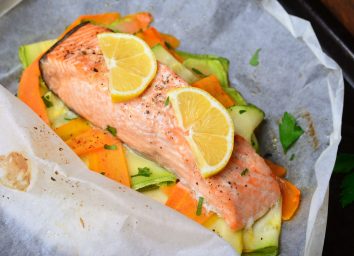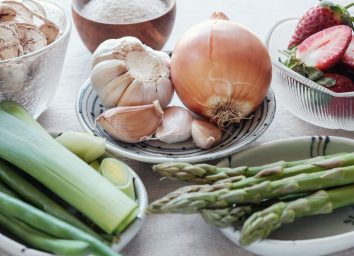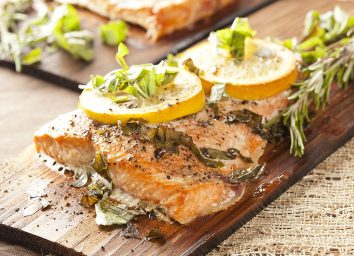27 Functional Foods for Better Health and Weight Loss
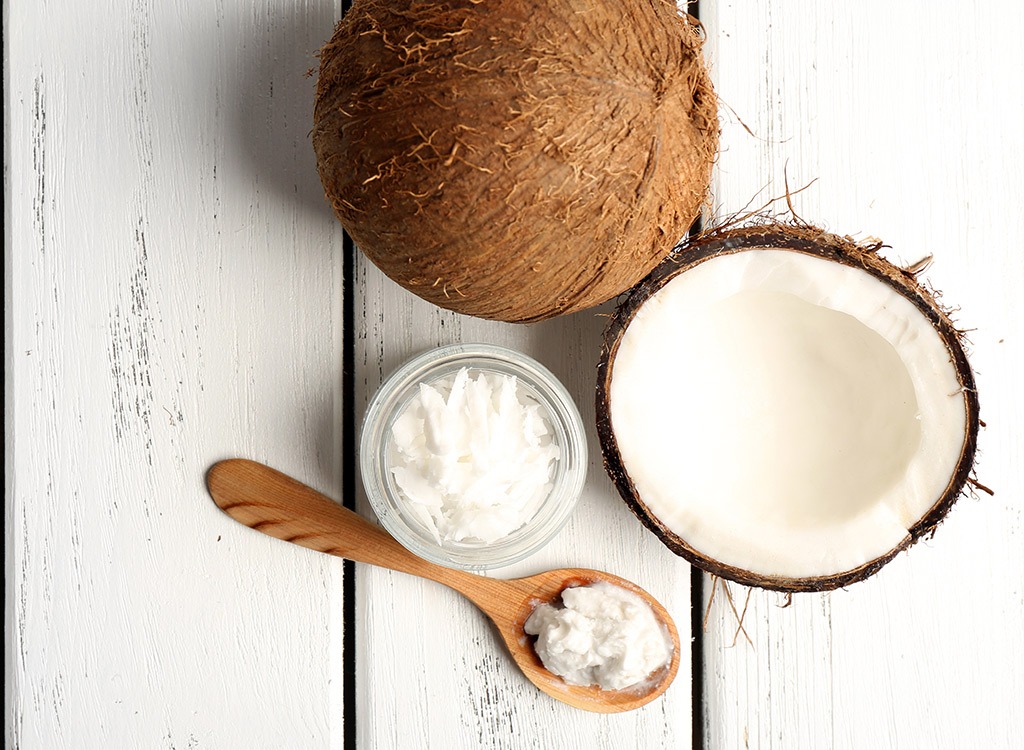
Yes, food provides us with the energy we need to survive. And yes, to most NFL players who eat pounds of the stuff every day, food is merely fuel. But there are some whole foods that won’t only meet your basal nutritional needs—they do much more. Think of it as nature’s form of a buy one, get one deal.
Dubbed “functional” foods by experts, these foods promote optimal health by helping to reduce the risk of disease, boost your metabolism, aid with digestion, improve nutrient absorption, and help you lose weight, all while satisfying your hunger cravings. Optimize your diet with these foods and tips so you can look and feel your best self!
Turmeric
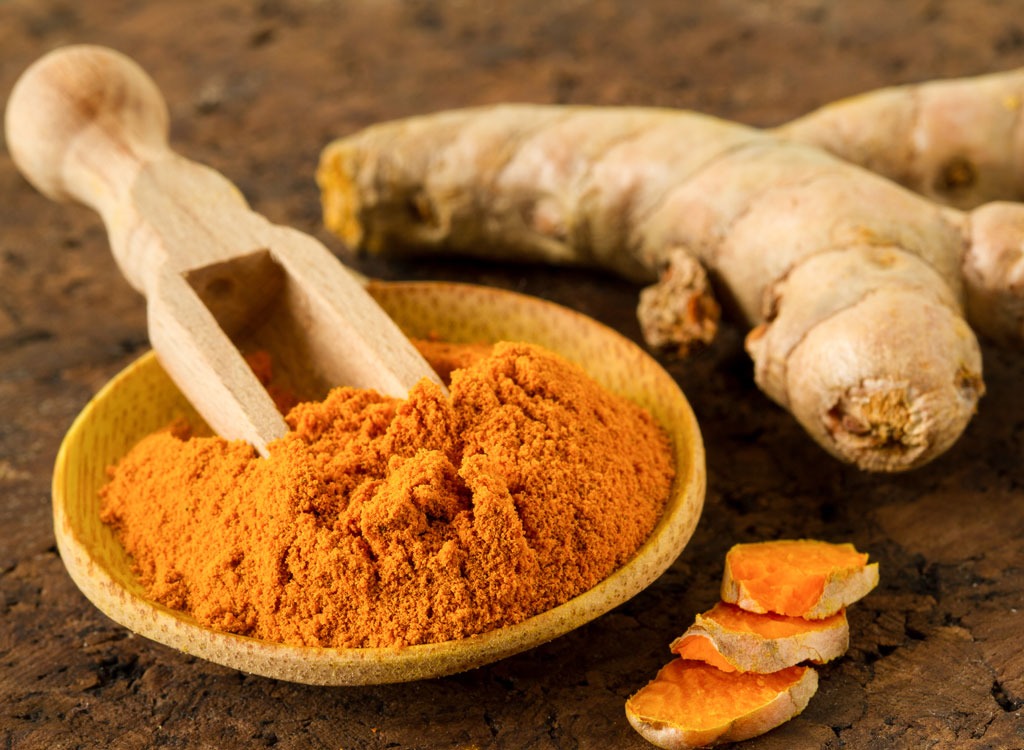
Best for: Reducing inflammation and fending off cancer
Turmeric is the new it-girl of spices and the reigning champ of functional foods for good reason. Whittling down the brown exterior of this knobbed and gnarled root reveals a tender, bright orange inside that’s teeming with antioxidants. Most of it is thanks to curcumin, the phenol that gives the spice its signature color and carries powerful anti-inflammatory properties which have been found to help alleviate joint pain from exercise and arthritis. Another gift is its ability to disrupt the growth and spread of cancer
Eat This! Tip:
Make a chicken or shrimp satay using a seasoning blend of turmeric, coriander, cumin, and cayenne. Or, you can whip up a curry-inspired smoothie with turmeric, coriander, ginger, pineapple, cilantro, lime, and coconut milk, or go a more understated route with just pineapple, banana, turmeric, ginger, yogurt, and coconut water.
Manuka Honey
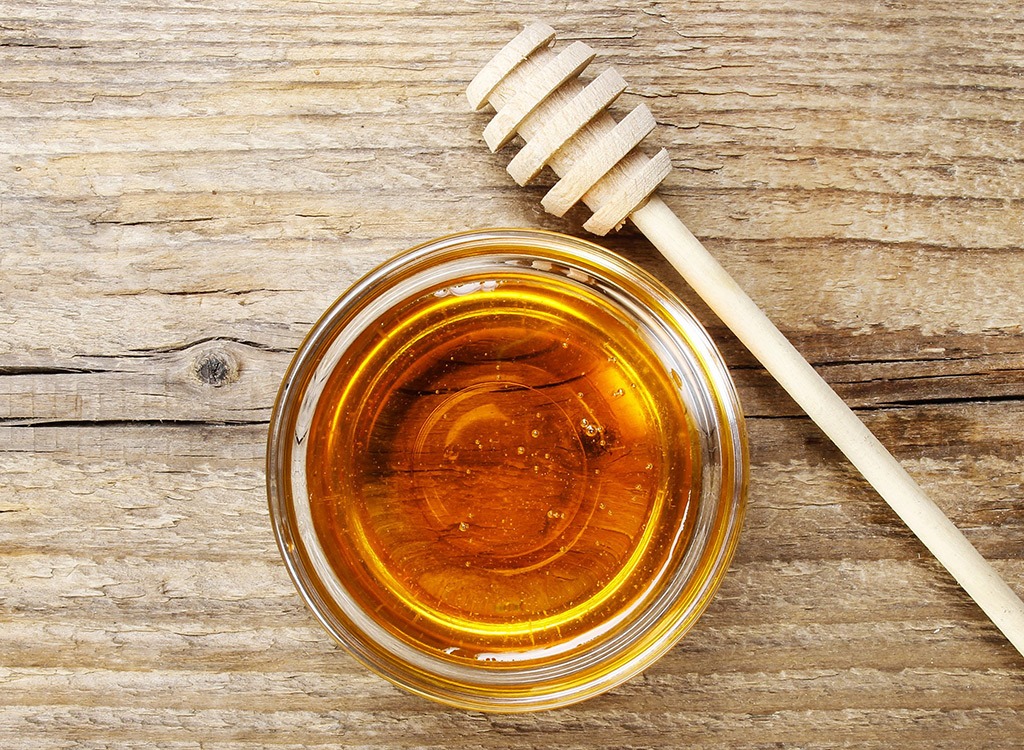
Best for: Healing digestive troubles by decreasing intestinal bacterial growth, boosts immunity, soothes sore throats, alleviates seasonal allergy symptoms, and improves inflammation-induced skin issues
This dark, thick honey produced in New Zealand from bees that feed on the manuka tree is infamous for its wondrous, healing properties. Honey contains trace amounts of digestive enzymes, proteins, vitamins, minerals, and antioxidants, of which many are beneficial polyphenols, flavonoids, carotenoids. Manuka honey, in particular, is richer in pathogen-fighting antibacterial enzymes and anti-inflammatory antioxidant compounds than traditional honey. Plus, its levels of oligofructose can increase levels of the beneficial gut bacteria, bifidobacteria, of which low levels have been tied to obesity. What this means for a flat belly: the antioxidants quell inflammation-inducing oxidative damage and boosting gut health will help soothe inflammation throughout the body (also why it can help relieve cold symptoms), which can result in a leaner you.
Eat This! Tip:
When purchasing manuka honey, be sure to grab one that carries a UMF (Unique Manuka Factor) of 10 or above. These honey options have the greatest levels of antioxidants and enzymes to support natural healing and to help with your bacterial balance. Add a spoonful to your tea or your morning bowl of oatmeal. Just don’t go overboard. The sweet nectar has 17 grams of sugar per tablespoon, so too much honey can make you heavy, rather than happy.
Apple Cider Vinegar

Best for: Burning fat and reducing harmful blood lipid levels that can lead to cardiovascular disease
Apple cider vinegar is composed mostly of acetic acid, which has been shown to delay gastric emptying and slow the release of sugar into the bloodstream—keeping you fuller longer. Plus, studies show acidic foods increase the rate at which the body burns off carbs, and the faster you burn off carbs, the sooner your body can start incinerating fat. Researchers found that study participants given ACV over a 12-week period lost more weight, body fat and inches from their middle than participants that were given a placebo, according to a study in Bioscience, Biotechnology, Biochemistry. How does it work? Besides maintaining stable blood sugar levels (which also can protect you against cardiovascular disease), ACV produces proteins inside the body that burn fat.
Eat This! Tip:
To reap the fat-burning properties, try using ACV in a flat-belly vinaigrette by combining one part vinegar to three parts olive or avocado oil, a tablespoon of minced shallot, half a teaspoon of manuka honey, and season with salt and pepper. It also makes a great pork marinade, livens up guacamole, and works wonders as a weight-loss boosting antioxidant juice: find out how in these 22 Apple Cider Vinegar Tips and Tricks and watch the pounds melt away.
Fermented Foods
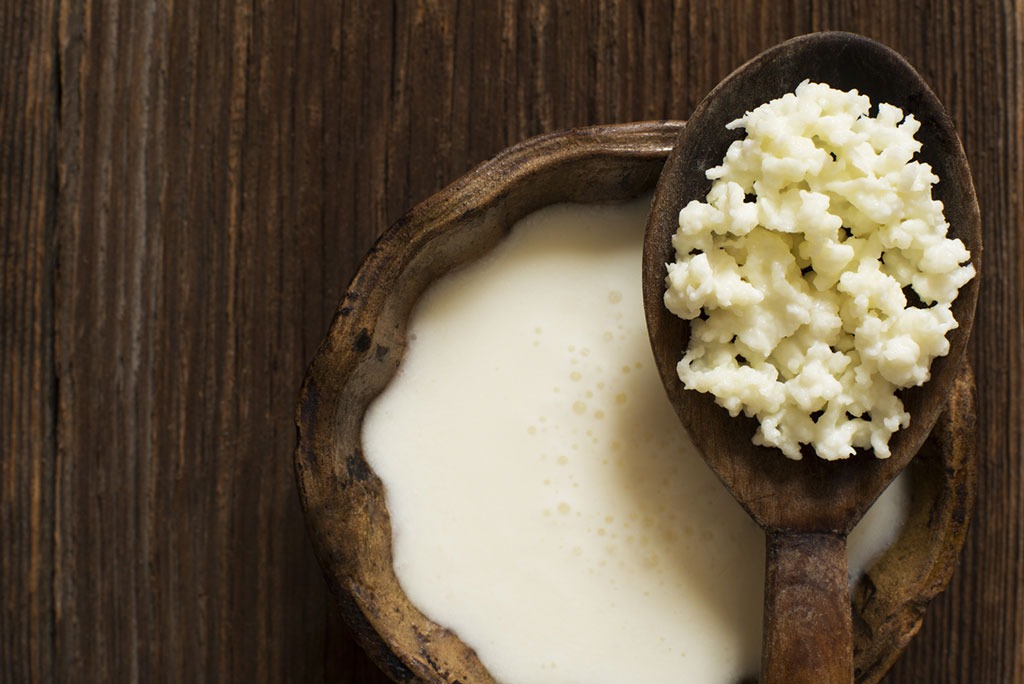
Best for: Improving gut health
Fermentation—a process by which natural, beneficial bacteria break down the starches in food—is not only good for preserving food; it’s also been found to increase levels of nutrients and have immense benefits on your gut health due to their levels of probiotics (those beneficial bacteria that pre-digest the food). Maintaining a proper balance between the beneficial bacteria and the disease-causing bacteria in your gut is essential to good health. Without good gut bugs, we’re prone to depression, skin conditions, and obesity. Lucky for us, one of the best ways to eliminate the bad bacteria and boost the health of the good is by eating and drinking fermented foods and beverages that are loaded with probiotics.
Eat This! Tip:
The most common source of fermented foods is yogurt, but rising in popularity is a drink called kefir. Kind of like a drinkable yogurt, kefir’s probiotics have been shown to colonize the intestinal tract, an important step in being able to actually aid in boosting gut health. It’s also a wonderful source of complete protein, vitamin B12, and other essential minerals.
Ginger

Best for: Aiding digestive issues
Fresh ginger root is full of nutrients that can benefit your body, boost your weight-loss efforts, and banish bloat. That’s because ginger acts as a digestive aid that can help relieve gassiness and bloating caused by certain foods and may help your tummy appear a little flatter as a result. That’s why it’s one of the 25 Best Foods That Beat Bloating.
Eat This! Tip:
We love steeping our own ginger tea by mincing fresh ginger foot into a mesh tea bag and letting it steep for 10 minutes. You can also grate this flavor-rich root over stir-fries, into baked goods or marinades.
Bitter Melon
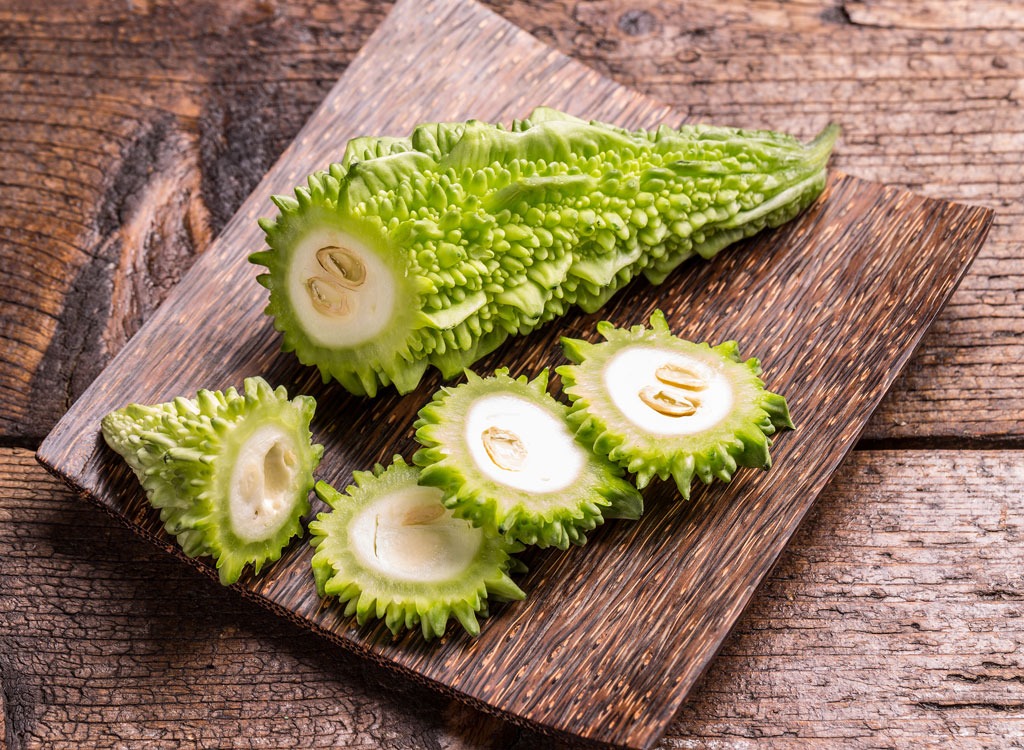
Best for: Boosting energy and acting as an antidiabetic
This prickly-looking cucumber is called a karela, also known as bitter melon or bitter gourd. Bitter melon is valued for a number of properties because it’s been known to reduce insulin resistance, therefore helping to reverse diabetes symptoms, as well as improve symptoms of gout and psoriasis. The high levels of B vitamins, calcium, iron, magnesium, and zinc help make this vegetable an immune booster and energizer.
Eat This! Tip:
You can add bitter melon juice into the mix of your favorite fruit smoothie. We’re partial to adding it to green smoothies by combining it with lemon, cucumber, apples, and kale.
Grapefruit
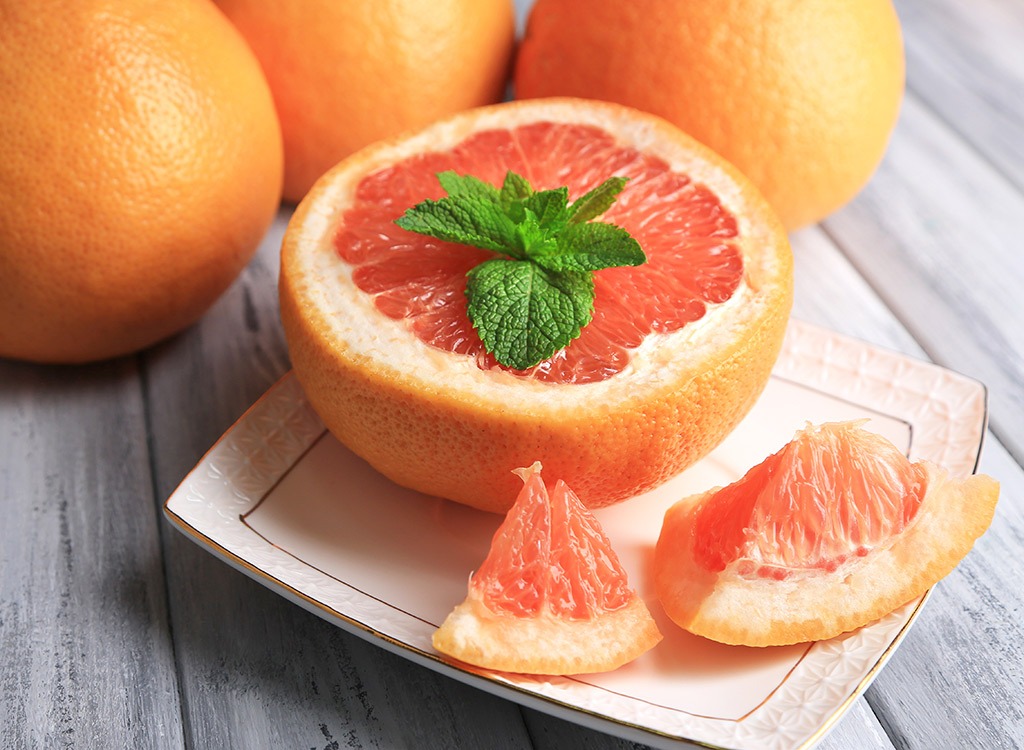
Best for: Boosting metabolism and burning belly fat
Eating half a grapefruit can enhance your body’s fat-burning performance, according to a study printed in the journal Metabolism. When participants ate half a grapefruit before meals, they shrunk their waits up to an inch—in only 6 weeks! Researchers attribute the effects to a combination of phytochemicals and vitamin C in the grapefruit which may help reduce visceral (belly) fat and lower cholesterol levels.
Eat This! Tip:
Consider having half of a grapefruit before your morning oatmeal, and slicing a few segments to a starter salad.
Fatty Fish
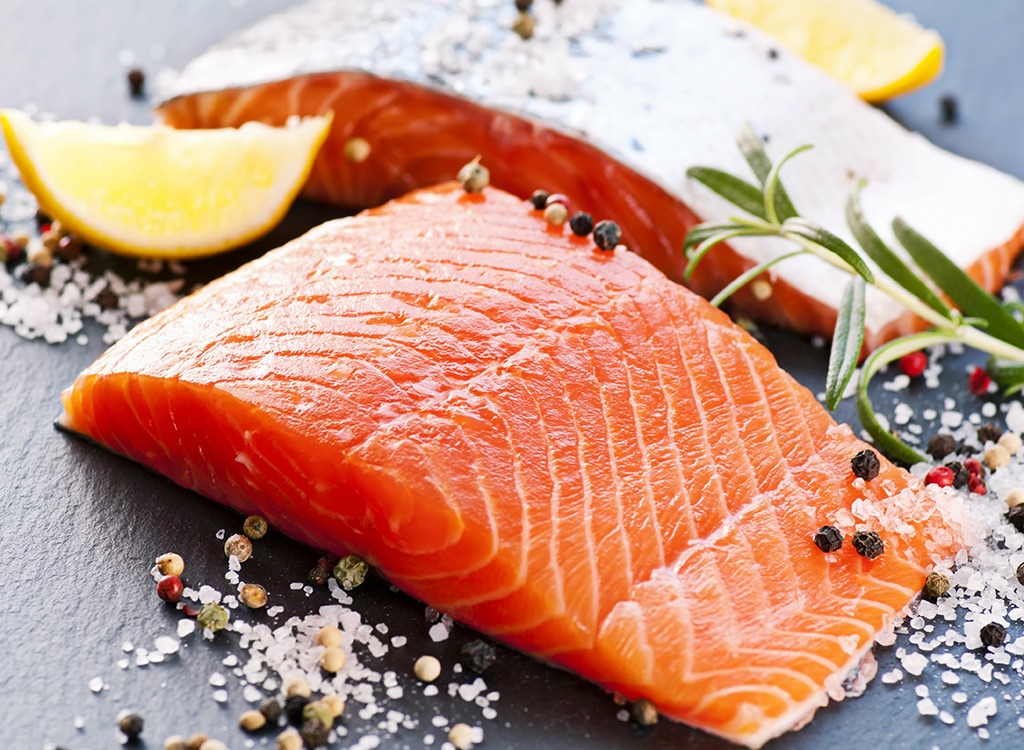
Best for: Strengthening your heart, flattening your belly, and sharpening your mind
Fatty fish are one of the best sources of omega-3 fatty acids because they contain the active forms DHA and EPA. (Plant sources of omega-3s contain ALA, which is converted into EPA and DHA in your body.) These healthy fats have anti-inflammatory properties that have been found to fight depression, mental decline, heart disease, arthritis, and osteoporosis.
Eat This! Tip:
Our favorite sources of fatty fish are wild salmon, canned white tuna, mackerel, and halibut. Try to get in at least two servings (just 3.5 ounces!) a week. Whip up seared salmon with lemon and paprika or throw a tuna fish salad onto whole wheat toast.
Bone Broth
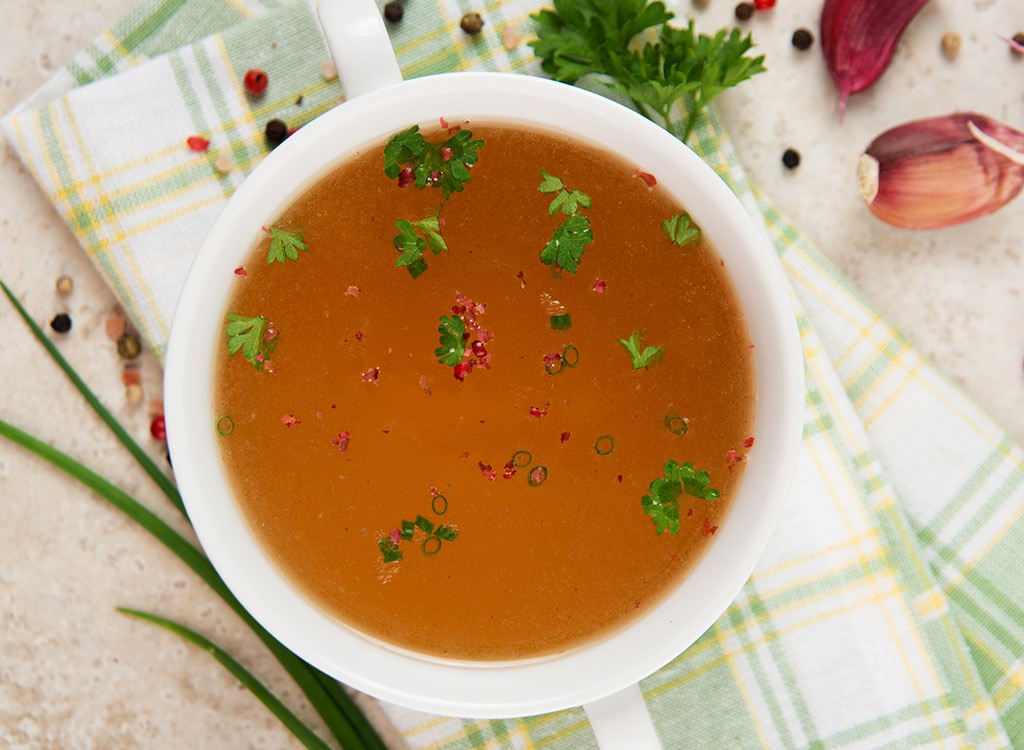
Best for: Improving nutrient absorption by healing your gut and diminishing joint pain
Bone broth is made by slowly cooking animal bones in water until their collagen is broken down into gelatin and dissolves into the water. When you ingest it, that gelatin can act as an intestinal Band-Aid, healing the lining of the digestive tract, which aids digestion and helps us absorb more nutrients. This same gelatin may also help strengthen bones and joints in a way that can relieve pain brought on by age-related arthritis and joint deterioration.
Eat This! Tip:
“If you sip about eight ounces a day and follow a diet rich in whole foods and low in added sugar and white flour, you can certainly reap the benefits,” Lauren Slayton, MS, RD, explains. Make it at home by simmering a couple pounds of organic, grass-fed beef bones in a pot of water from 12 to 24 hours. Drink it by the cup or use it in one of our 20 Best Broth-Based Soups for Weight Loss.
Avocado Oil
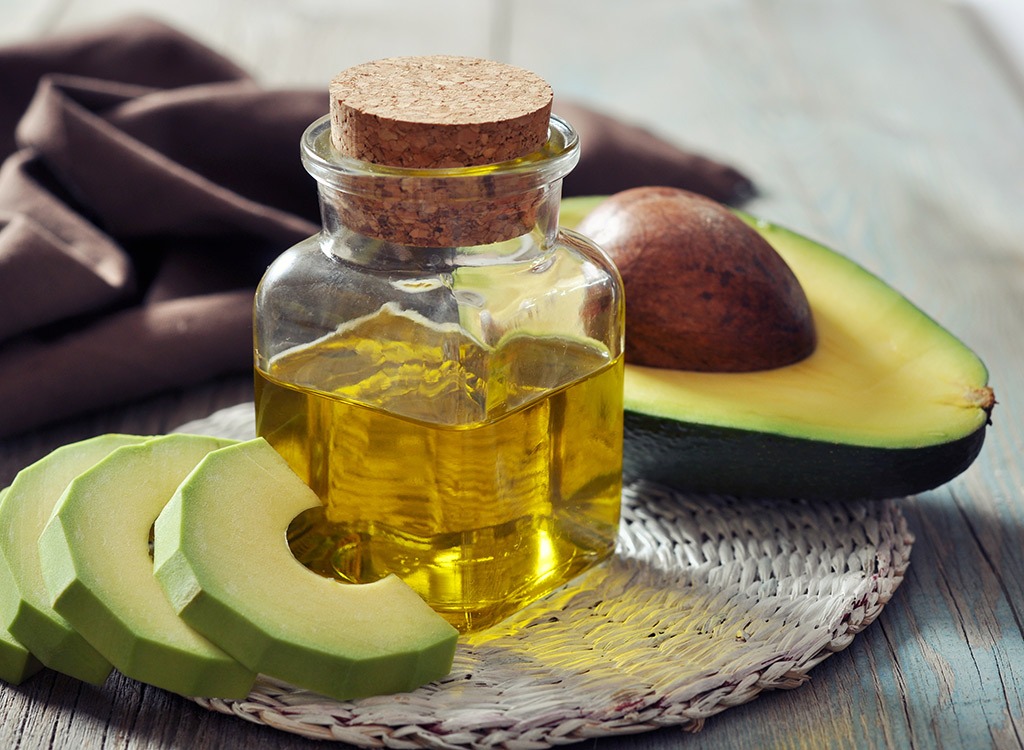
Best for: Improving heart health
Because avocado oil is made from pressed avocados, it’s rich in the same heart-healthy monounsaturated fats that may help improve cholesterol, prevent arterial damage, reduce the risk of heart disease, and ward off hunger. It also contains vitamins B and E, eye-protecting antioxidants lutein and zeaxanthin, and bloat-banishing potassium.
Eat This! Tip:
The oil has a mild grassy taste and a light avocado aroma, but it’s still more neutral-tasting than olive oil. Another advantage compared to the Italian oil is its high smoke point, which allows you to cook at a higher temperature without producing cancer-causing compounds. It also works well drizzled over breads, salads, and fish. Want to learn more about oils? Check out our report, 14 Popular Cooking Oils and How to Use Them.
Blueberries
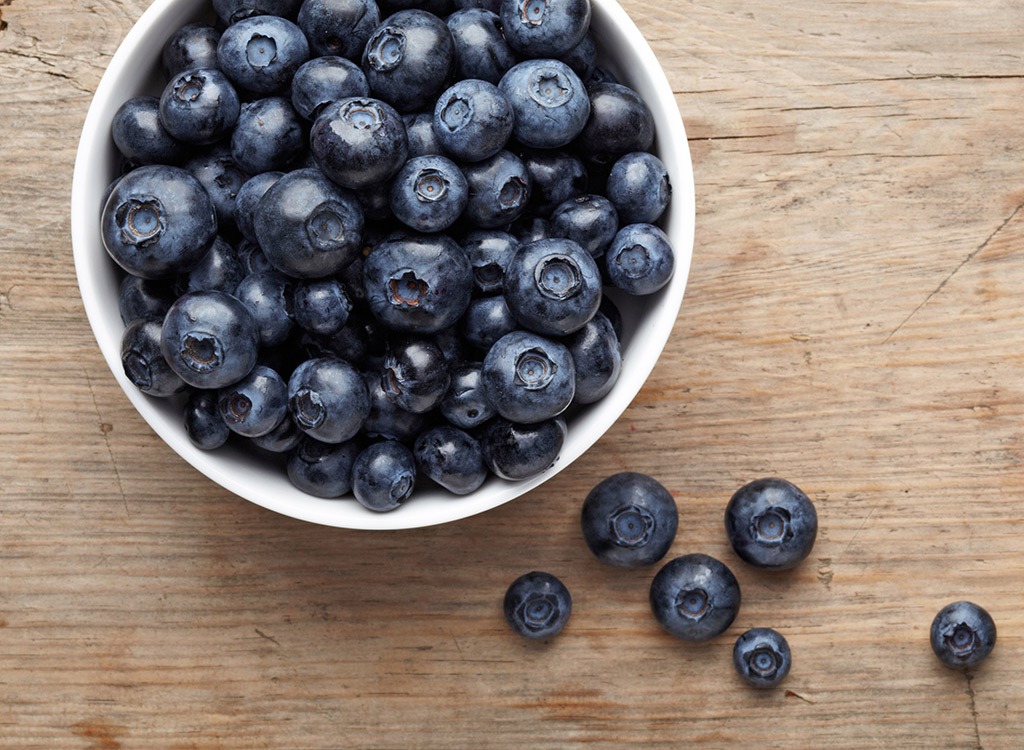
Best for: Fending off heart disease, burning belly fat, and reducing risk of age-related disease
Berries are packed with polyphenols, powerful natural chemicals that can help you lose weight, and even stop fat from forming. Blueberries are a nutritional powerhouse because they’re full of a specific group of polyphenols, anthocyanins, which put the blue in blueberries. A recent American Journal of Clinical Nutrition study of more than 200,000 people found that a higher consumption of fruits with anthocyanins was associated with a lower risk of type 2 diabetes and obesity. They’re one of the best foods to help you never feel old because these same blue-hue antioxidants help protect cells from age-related damage by changing the way neurons in the brain communicate and reducing the accumulation of protein clumps most frequently seen in Alzheimer’s.
Eat This! Tip:
Toss a cup of blueberries into a yogurt smoothie with some ground flaxseed and almond butter. Or, throw them in a cup, zap ’em in the microwave for 10 seconds, and mash them up to flavor your overnight oats. You can also eat them raw as a snack.
Walnuts
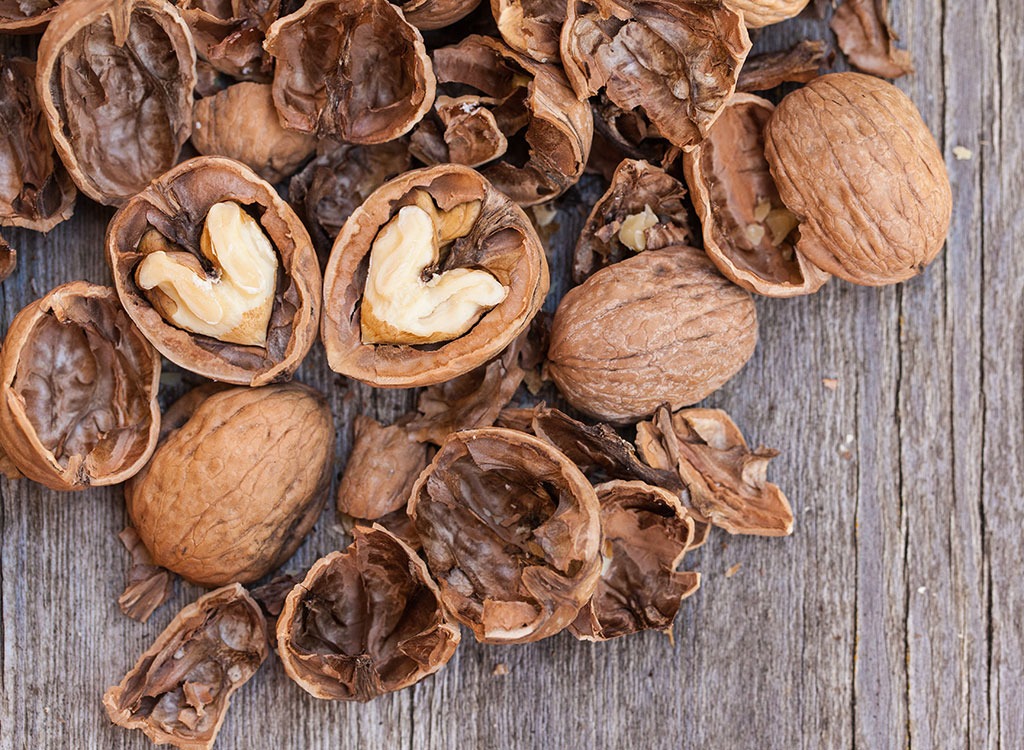
Best for: Lowering rates of heart disease, bad cholesterol levels, inflammation, and total mortality
The myth that fatty nuts are bad has been busted. Lisa Moskovitz, RD, CDN, says, “Nuts […] are chock full of nutrients from heart-healthy fiber, MUFAS (mono-unsaturated fats), PUFAS (poly-unsaturated fats) like omega-3s, bone-building magnesium, calcium and energizing iron.” And walnuts hit high on every mark. These heart-shaped nuts pack the biggest omega-3 punch of any nut or seed, and they’re also high in disease-fighting antioxidants. Plus, they contain an MUFA called oleic acid, which has been shown to help improve immune system function, enhance uptake of essential fat-burning nutrients, and lower cholesterol. The benefits of walnuts include helping to protect against heart disease, reducing blood pressure, and decreasing inflammation in blood vessels during times of stress.
Eat This! Tip:
Toss some into salads or eat a handful as an afternoon snack. Mixed nuts are one of the best 23 High-Protein Snacks. But because they’re high in energy-dense fats, which have more calories per gram than protein or carbs, always be sure to eat them in moderation.
Erythritol
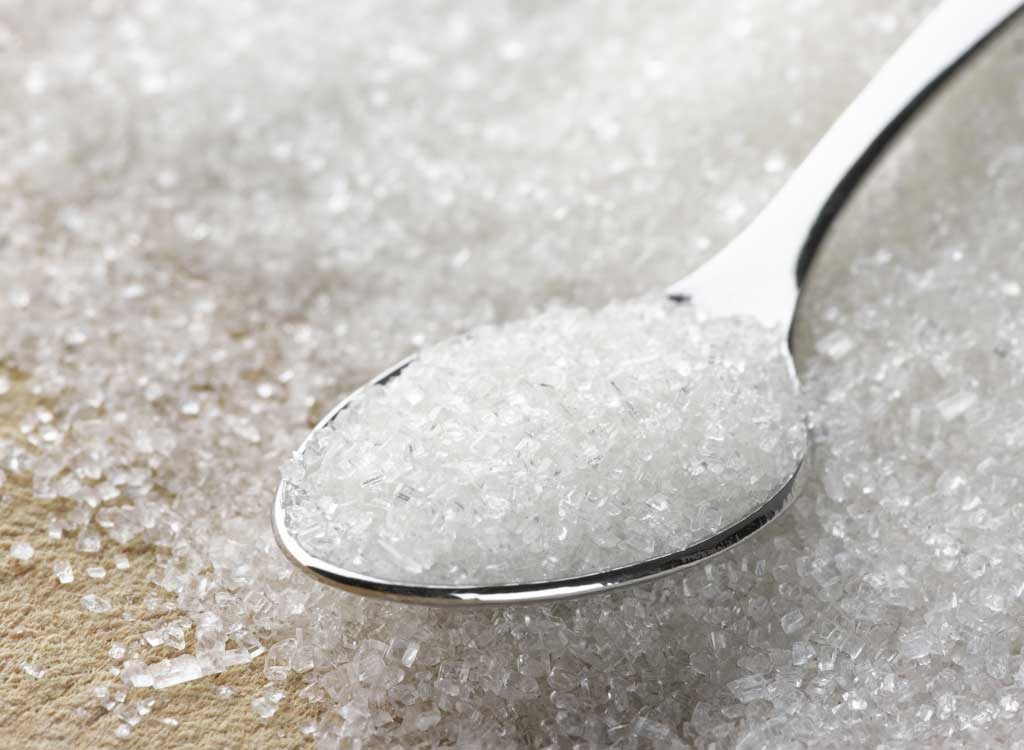
Best for: Reducing risk of dental cavities
Erythritol is a low-calorie sugar alcohol, also known as a polyol. Sugar alcohols are touted for their benefit of not aiding in tooth decay like sugar does. However, these sweeteners can have a negative impact on gas and bloat because they’re only partially digested before moving through your digestive tract. But among all the polyols, erythritol doesn’t cause the same digestive problems as other sugar alcohols. That’s because it’s found naturally in many foods that humans have consumed for millennia—grapes, pears, melons, and even mushrooms—so our digestive system is familiar with it. We also give it points for having no effect on our blood glucose levels and providing no belly-fat-inducing fructose. What’s more, erythritol is an antioxidant, so it helps reduce oxidative stress in the body by scavenging free radicals.
Eat This! Tip:
If you aren’t sensitive to its laxative effects, you can sub erythritol for those artificial sweeteners you’ve been dumping in your cuppa joe. Curious about how erythritol stacks up against Splenda and natural sugars like maple syrup? Read up in our exclusive report, Every Popular Added Sweetener—Ranked!
Spinach
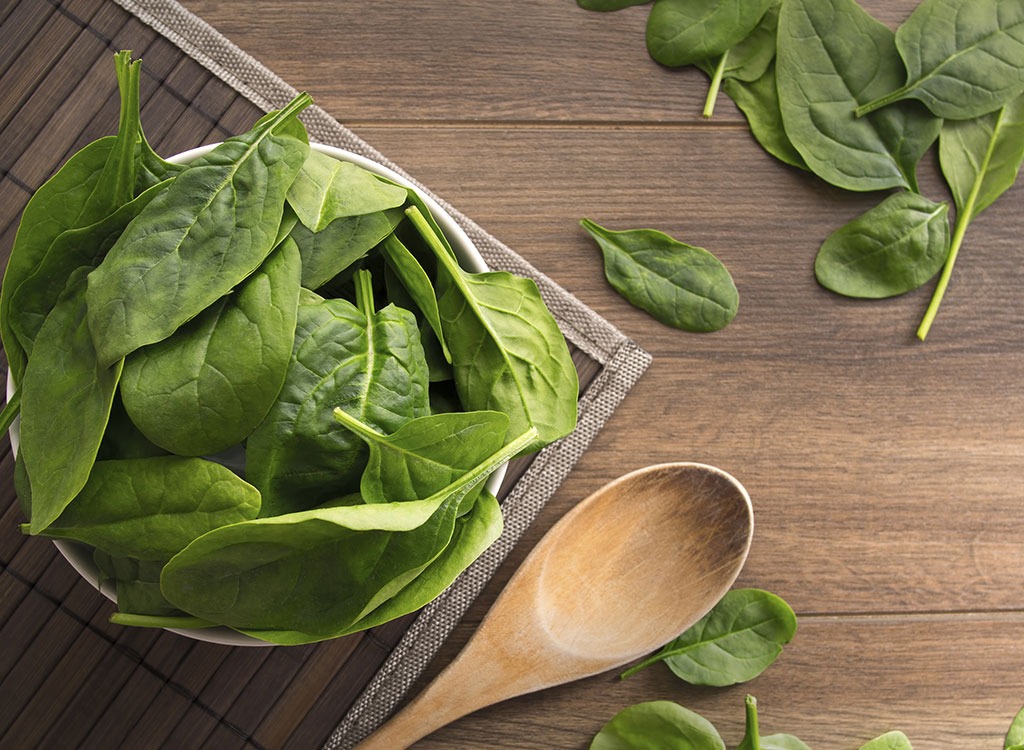
Best for: Gut health, immunity, eye health, muscle building, and metabolism regulation
For all the health benefits you get from spinach, this veggie might be one of the most underrated superfoods on the market. For starters, it’s full of the carotenoids lycopene, beta-carotene, lutein, and zeaxanthin. Beta-carotene acts as an antioxidant, neutralizing free radicals which may damage cells and lutein and zeaxanthin support maintenance of eye health. It’s also one of the top sources of essential nutrients for those following a plant-based diet: spinach is full of non-dairy calcium, which may reduce the risk of osteoporosis; and is a non-meat source of magnesium, a mineral that supports the maintenance of muscle function and immune health; iron, which helps transport oxygen throughout the body; and vitamin B2, which helps regulate your metabolism. Oh, and it also acts as a prebiotic, promoting the growth of good gut bacteria and preventing the colonization by bad bacteria.
Eat This! Tip:
From a nutrition standpoint, a combination of both raw and cooked spinach will provide you with the most health benefits. Cooking spinach allows the iron, lycopene, beta-carotene, and lutein to become more bioavailable and more easily absorbed by our bodies. And when you eat it raw, you’ll protect the delicate, water-soluble vitamins that are destroyed through cooking: vitamins A and C, B-vitamin folate, minerals such as hydrating potassium as well as bone-building calcium, magnesium, and manganese. Find out the best way to cook your food and preserve the most nutrients.
Oats
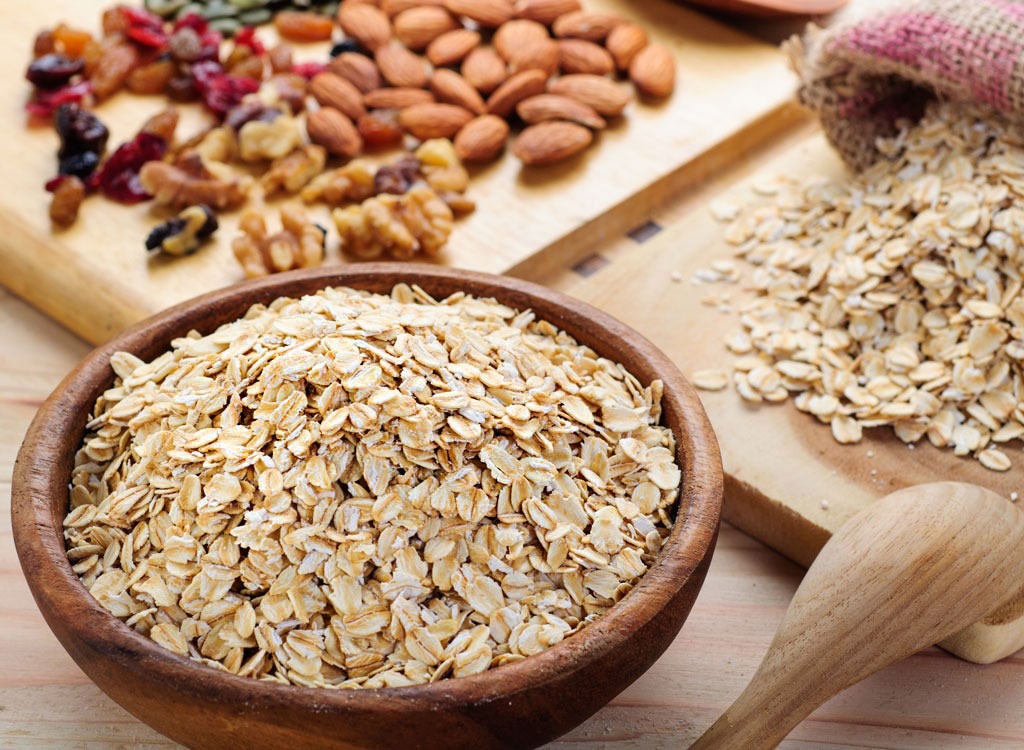
Best for: Improving satiety, burning fat, absorbing nutrients, and improving gut health
Oats may be the perfect weight-loss tool because they help you feel fuller thanks to their slow-digesting fibers, which also reduce spikes in blood sugar, but that’s not all they’re good for. Just three grams of oat fiber called beta-glucan has been shown to reduce bad cholesterol levels from 5 to 10 percent, and thus reduce your risk of coronary heart disease.
Eat This! Tip:
The best way to reap the prebiotic powers of oats is by eating them raw—in overnight oats. That’s because the raw oats are a source of resistant starch, which passes through your gut undigested, feeding your gut bugs so they can ferment them into anti-inflammatory fatty acids. Otherwise, here are 15 More Ways to Lose Weight with Oatmeal. We like #6, using them to create a savory oat risotto!
Whole Grains
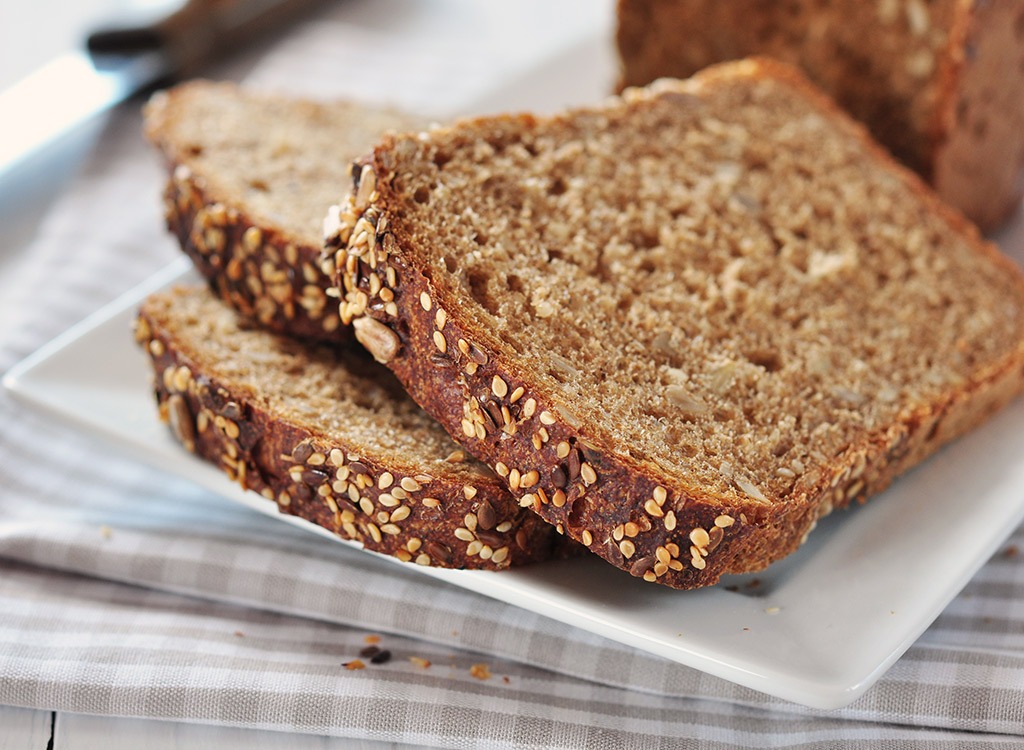
Best for: Reducing inflammation
Inflammation has been implicated in an array of health issues, but most noticeably with causing weight gain and stifling slim-down efforts. Getting more whole grains into your diet will help you reduce inflammation in more ways than one. For starters, whole grains such as brown rice, quinoa, and millet are all packed with fiber that helps produce butyrate, a fatty acid that turns off genes related to inflammation and insulin resistance. Additionally, the high B vitamin content of whole grains (which is nearly entirely lost during the refinement process) also helps reduce the inflammatory hormone homocysteine in the body. And secondly, if you’re replacing inflammatory refined grains with whole grains, you’ll naturally reduce inflammation.
Eat This! Tip:
Don’t confuse whole grain for multigrain—multigrain simply means that there are different types of grains present, but typically these are just pulverized flours.
Natto

Best for: Improving cardiovascular (heart) and bone health
We already mentioned fermented foods, but natto is one with an additional benefit. This Japanese food is made by boiling and fermenting soybeans with bacteria that increase the beans’ nutritional value. Here’s what sets it apart: After fermentation, natto is the highest dietary source of menaquinone-7, or vitamin K2—a vitamin which is crucial for proper bone health and cardiovascular health. Studies have connected higher intake of the vitamin with preventing fractures in postmenopausal women with osteoporosis. If that’s not beneficial enough, vitamin K2 also promotes skin elasticity to help prevent wrinkles.
Eat This! Tip:
Worried about eating soy? Don’t be! We did the research, and we’re giving non-GMO soy that has been fermented (like natto) the A-okay. But if you’re still not a fan, you can also get vitamin K2 from grass-fed butter, meat, and egg yolks; just know that this is the shorter chain version that won’t remain in your system for as long.
Eggs
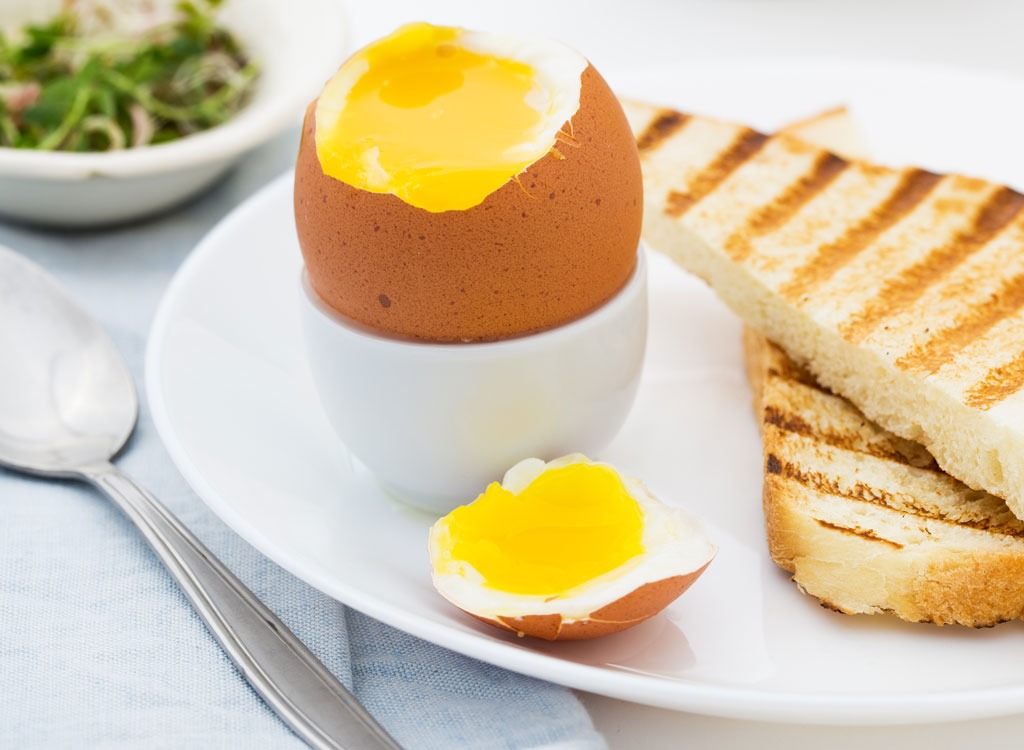
Best for: Boosting immunity, and helping to blast away your love handles
The “incredible, edible egg,” is right! Eggs are the ultimate weight loss weapon. They’re one of the densest sources of protein—a macronutrient that is essential in building up calorie-burning muscle mass—and choline, a B vitamin that is essential for cell functioning as well as a compound that turns off the genes that cause your body to store fat around your liver. Speaking of blasting away fat, eggs are also rich in the anti-inflammatory, immune-boosting, and bone-strengthening vitamin D. Previous research has found a correlation between vitamin D deficiency and increased levels of pro-inflammatory markers—a well-known characteristic of overweight and obese people.
Eat This! Tip:
To reap the best of the protein and vitamin worlds, fry your eggs over-easy, sunny-side up, poach them, or soft boil them. The common thread in these four methods? The yolk is runny but the whites are cooked. Scientists have found that a runny yolk preserves the highest amount of vitamins while cooked egg whites help to denature the protein, making it easier for you to digest.
Beans

Best for: Reducing your risk of heart disease and colon cancer, and keeping you full
Beans, such as black, pinto and garbanzo, serve up a healthy dose of muscle-building protein, heart-protecting folate, and are some of the most inexpensive high fiber foods, particularly in soluble fiber. This fiber, as opposed to insoluble fiber, is particularly beneficial. Because your body can’t break down soluble fiber, it takes up space in your belly without getting absorbed by your blood, slowing digestion and leaving you fuller for fewer calories. Jennifer Glockner, RDN and author, tells us consuming more soluble fiber “may help to reduce blood cholesterol and reduce the risk of heart disease and colon cancer.” That’s because this fiber binds to and expels bile and bad LDL cholesterol from your body.
Eat This! Tip:
Add black beans to quesadillas, pinto beans into an omelet, mash navy beans on toast, or blend chickpeas into hummus. Need more ideas? Check out these 25 Recipes and Ideas for Pulses.
Olive Oil
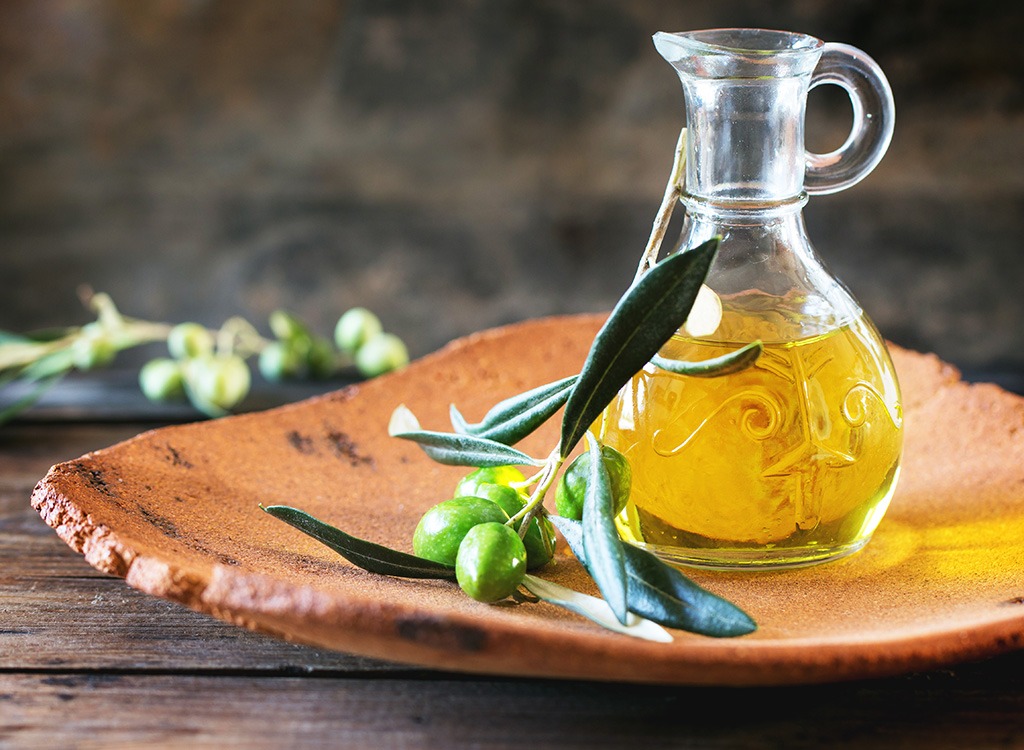
Best for: Improving heart health
The Mediterranean diet has finally got it right. Those who regularly consume this diet—which is rich in extra virgin olive oil—have a 30 percent lower risk of heart attacks, strokes, and deaths from heart disease in people at high cardiovascular risk, according to a study in the New England Journal of Medicine. Not only have studies connected consumption of this oil to lower blood pressure, but regularly consuming EVOO has been shown to boost levels of adiponectin, a hormone that breaks down fat. Additionally, EVOO is natural inflammation fighter thanks to something called “oleocanthal.” This compound—found only in unrefined, phenolic-rich, extra virgin olive oils—prevents the production of pro-inflammatory COX-1 and COX-2 enzymes, which have been implicated in increasing risk of serious cardiovascular events.
Eat This! Tip:
Drip some extra virgin olive oil over salads, drizzle it over cheese, use it to flavor stews, and even blend with basil to serve over freshly grilled veggies. Whichever way you like to use it, just make sure you store it properly once you’re done. Because the active phenolic content diminishes with time—especially when exposed to heat and light—EVOO should be stored in a cool dark place and used within a couple months of opening a container—not left out on your counter.
Green Tea
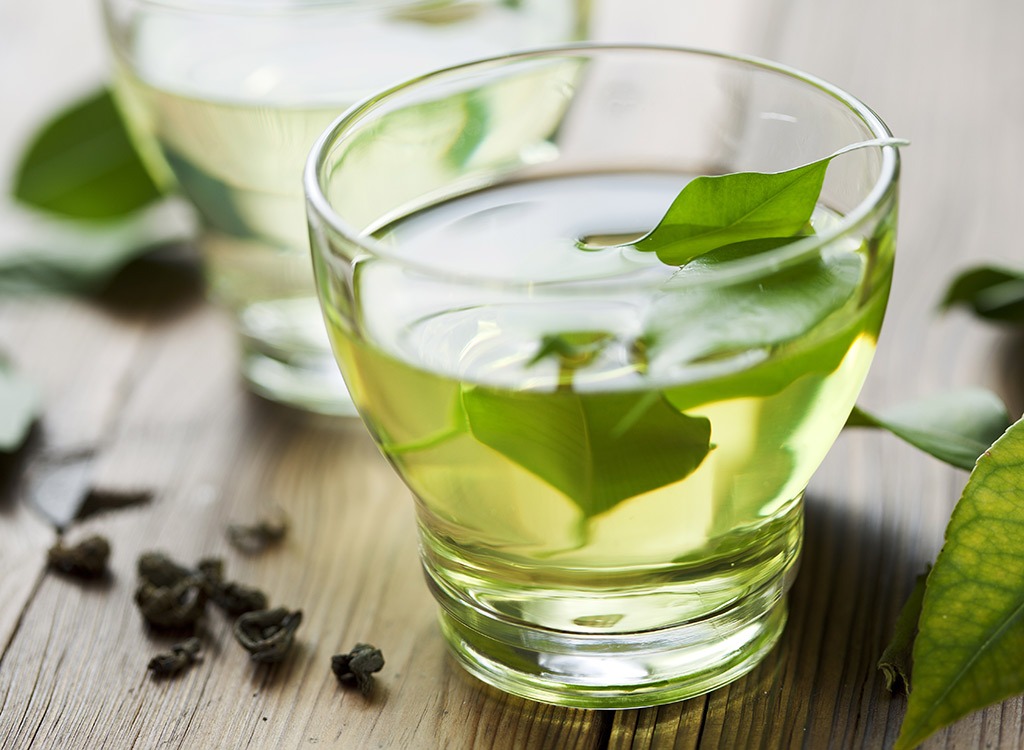
Best for: Boosting metabolism
This weight loss elixir is teeming with catechins—a group of antioxidants with proven anti-inflammatory and anticancer properties. And perhaps best of all, the green drink is loaded with a particular catechin known as epigallocatechin gallate. Also known as EGCG, this antioxidant has been proven to boost lipolysis (the breakdown of fat) and ketosis (the conversion of fat into energy), block adipogenesis (the formation of new fat cells)—a surefire recipe for boosting your metabolism!
Eat This! Tip:
Don’t just drink it alone; pair your green tea with a source of omega-3 fatty acids like fish, chia seeds, or flax seeds. The omega-3 fatty acids have been found to enhance the efficacy of EGCG.
Broccoli
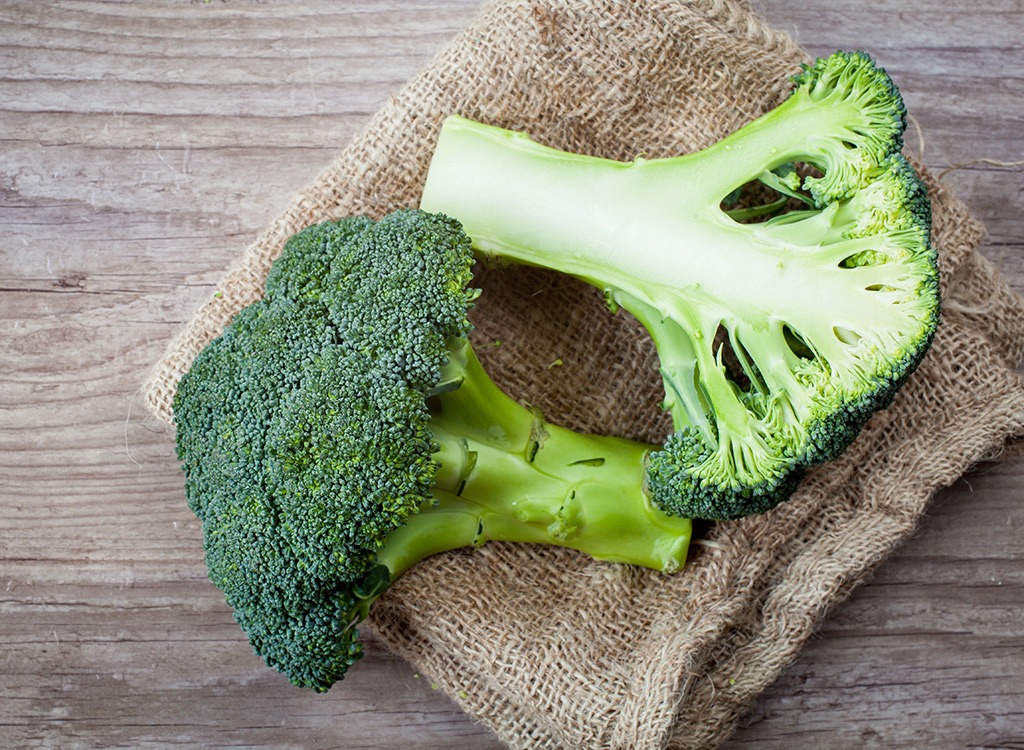
Best for: Detoxifying and helping to prevent cancer
Besides the fact that broccoli’s high fiber content will help fill you up and clean you out, this crucifer will also help you fend off diseases. That’s thanks to the powerful compound sulforaphane. While it might be hard to pronounce, its benefits are clear—the chemical works on a genetic level to effectively “switch off” cancer genes, leading to the targeted death of cancer cells and slowing of disease progression. It also works to bolster antioxidant defenses and may enhance the liver’s detox system to clear out health-harming compounds.
Eat This! Tip:
To reap the immense benefits, make sure you’re not eating this food wrong. When crunching on this crucifer, be sure to pair broccoli with a food that contains the sulforaphane-activating enzyme, myrosinase: horseradish, mustard, wasabi, or arugula.
Brazil Nuts
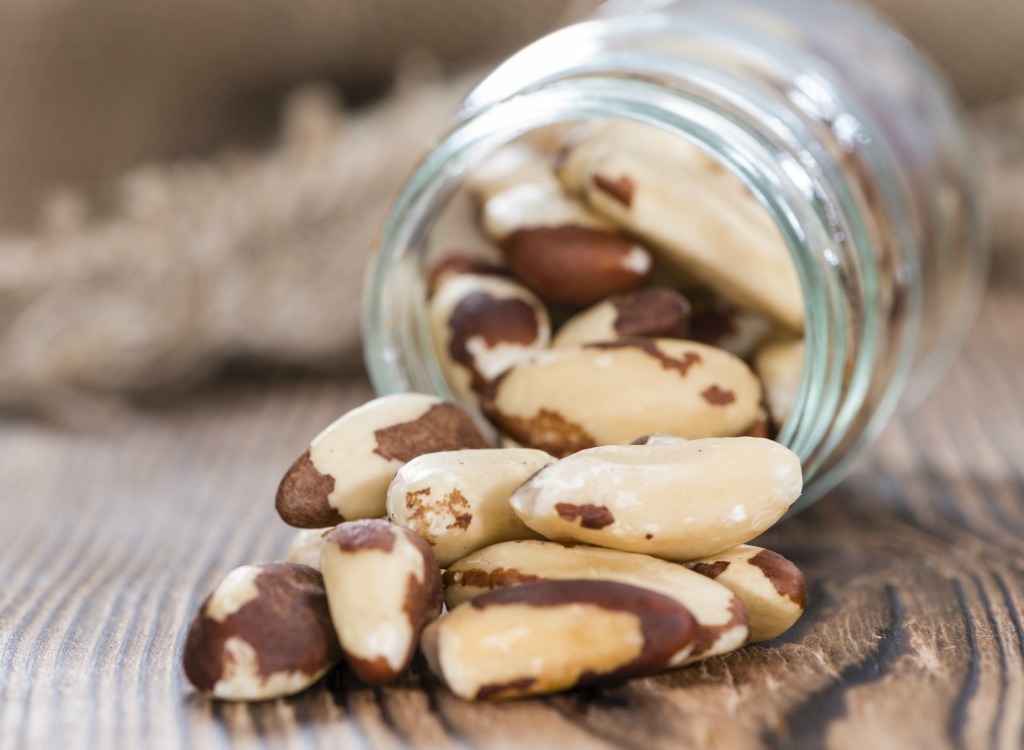
Best for: Maintaining proper hormone health and a glowing complexion
Brazil nuts are the closest thing we have to a naturally-occurring selenium supplement. Just one nut has over 135 percent of your daily recommended intake! Why is that important? It’s because this trace mineral plays an essential role in hormone and metabolism health, helping to protect your thyroid gland—a gland that controls your metabolism—from inflammatory byproducts of thyroid hormone production. Selenium can also boost the production of collagen and preserve elastin, two proteins that work together to keep your skin smooth and tight.
Eat This! Tip:
All you’ll have to do to reap the benefits is nosh on a single Brazil nut a day!
Coconut Oil

Best for: Maintaining energy levels and improving gut health
Wondering about the benefits of coconut oil? Here’s one you might not have heard: it can help improve your gut health. How so? Well, coconut oil contains a potent antimicrobial—caprylic acid—which acts to destroy bad bacteria and candida that aggregate in your belly. Candida, that is, being a fungus that can break down your intestinal walls and decrease stomach acid, which would otherwise cause inflammation, poor digestion, and breakouts. Yikes.
Eat This! Tip:
A couple tablespoons a day to fry an egg, sear your chicken breast, or even add to your morning smoothie can help keep your gut health on track. And that’s not all it will do. This superfood can supercharge your weight loss, thanks to its slow-digesting, medium-chain triglycerides like lauric acid, which will keep your appetite in check.
Apples With Skin
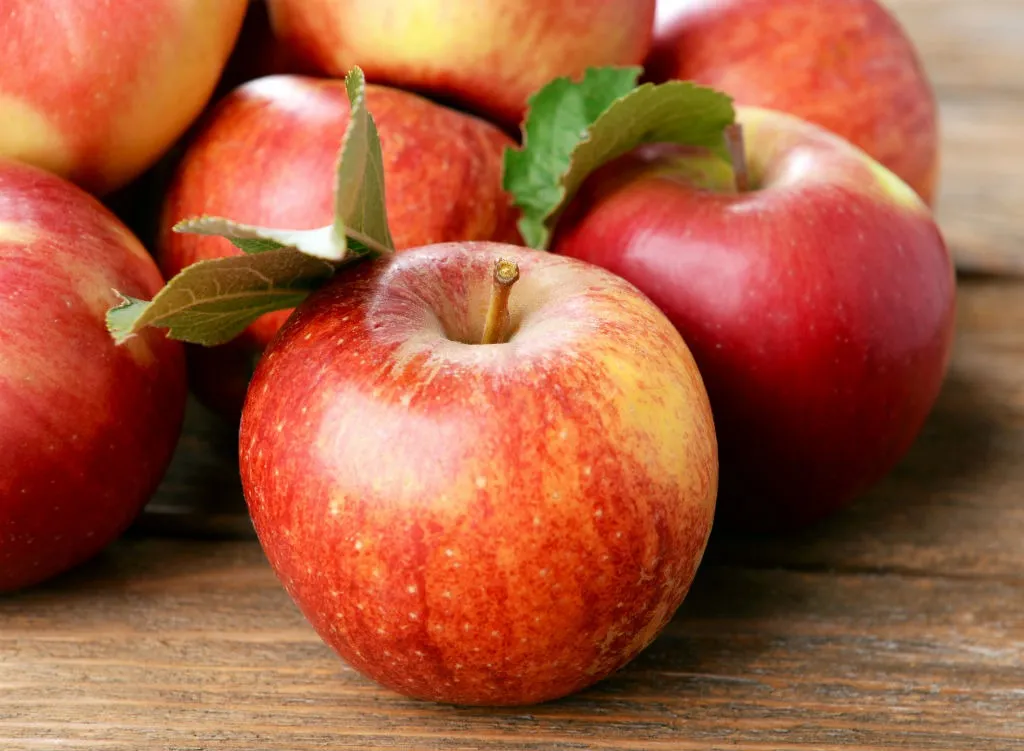
Best for: Boosting energy and endurance
One of nature’s best grab-and-go fruits, apples will both squash your hunger pangs and give you a jolt of energy. Not only is the fruit a great source of healthy, energy-revving carbs, it’s full of water and fiber to keep your blood sugar levels stable. Not to mention, apples are packed with heart-healthy flavonoids like quercetin—an antioxidant that has been found to play a role in improving exercise endurance and staving off the belly-fat-storing hormone cortisol.
Eat This! Tip:
Drizzle a bit of lemon juice on cut apple slices and eat them with your favorite nut butter. Just remember to leave the skin on! Without it, you’ll only consume a mere 2.1 grams of dietary fiber for an apple that could have given you a satiating 4.4 grams. Leaving the skin on is what makes apples one of the 20 Most Filling Fruits and Veggies!
Pickles
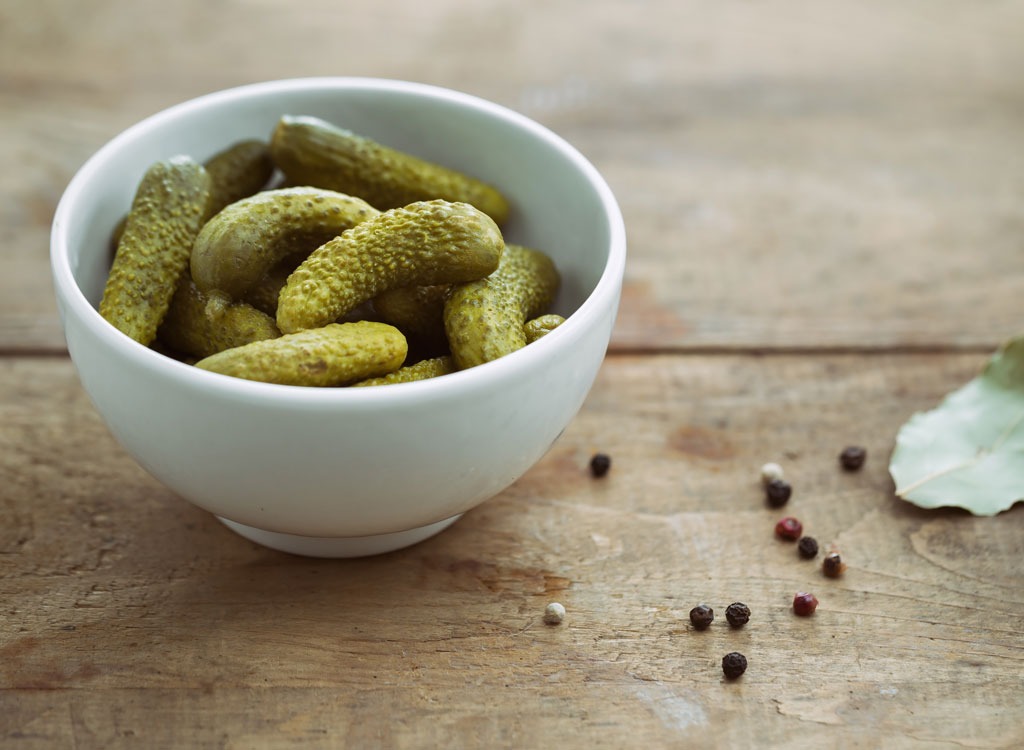
Best for: Fending off hunger pangs
Besides being low calorie and full of fiber, pickles are also a solid choice for your waistline because they’re brined in vinegar. This tart condiment is full of something called acetic acid. Studies show that many acidic foods help increase the rate at which the body burns off carbs by up to 40 percent—and the faster you burn off carbs, the sooner your body starts incinerating fat, which can help you get that lean look you crave.
Eat This! Tip:
Add tangy pickles to your favorite sandwich or burgers. Or, better yet, just munch on them whole and you won’t even steal a second peek at those office donuts. Do you ever feel like you cave to cravings all too easy? Read up on these 26 Ways to Feel Full While You’re Eating Less.
Red Peppers
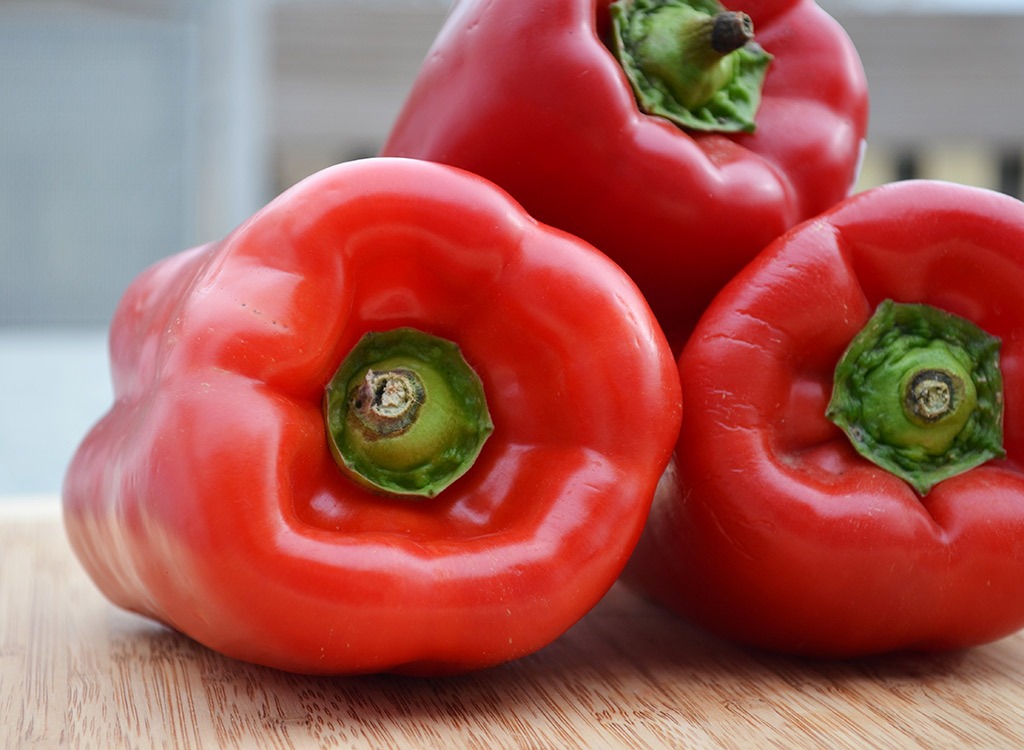
Best for: Minimizing stress and boosting immunity
Oranges have nothing on red peppers when it comes to vitamin C. Although the citrus fruit has long been connected to the antioxidant vitamin, red peppers actually offer the highest amount of this inflammatory-biomarker-reducing compound: a staggering 300 percent in a mere half a cup! Not only does vitamin C boost your immunity and quell inflammation, but the nutrient also counteracts the stress hormones that trigger fat storage around your belly.
Eat This! Tip:
Dip a few slices of red bell peppers into hummus for a snack, add the veggie to omelets and salads, or throw some chicken in a corn tortilla with salsa and slices of avocado, red pepper, and onion for a Tex-Mex-inspired fat-fighting dinner. Its fat-blasting powers make it one of the 35 Foods To Get You Bikini Ready.
